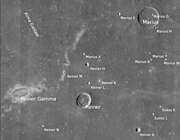Reiner Gamma
Coordinates 7°30′N 59°00′W / 7.5°N 59.0°W | | |
| Diameter | 70 km (43 mi) | |
|---|---|---|
| Eponym | Reiner crater | |
Reiner Gamma (γ) is a geographical feature of the Moon known as a lunar swirl. It is one of the most visible lunar swirls from Earth, visible from most telescopes.[1] It was originally thought to be a lunar highland, but scientists eventually realized that it cast no shadow on the moon.[2]
Origin
The origin of Reiner Gamma—like other lunar swirls—is not completely understood. It is associated with a localized magnetic field, but not with any particular irregularities in the surface. Similar features have been discovered in Mare Ingenii and Mare Marginis by orbiting spacecraft.[3] The feature on Mare Ingenii is located at the lunar opposite point from the center of Mare Imbrium. Likewise the feature on Mare Marginis is opposite the midpoint of Mare Orientale. Thus one hypothesis is that the feature resulted from seismic energies generated by the impacts that created these maria.[citation needed] However, no such lunar mare formation is on the opposite side of the Moon from Reiner Gamma.
Location and Features

Reiner Gamma is located on the
The central feature of Reiner Gamma resembles the dipolar formation created by iron filings on a surface with a bar magnet on the underside. Low-orbiting spacecraft have observed a relatively strong magnetic field associated with each of these albedo markings. Some have speculated that this magnetic field and the patterns were created by cometary impacts. However the true cause remains uncertain.
Reiner Gamma's magnetic field strength is approximately 15
In early
-
NASA Clementine UV-VIS color image of Reiner Gamma
-
Oblique view from Lunar Orbiter 2, with the Marius Hills in the background.
-
Beginning with a full-globe view of the lunar near side, the camera flies to a close-up, increasingly oblique view of the lunar swirl.
-
Reiner and Marius areas
References
- ^ "Lunar Swirls". Retrieved 18 April 2017.
- ^ "Bubble Bubble - Swirl and Trouble". Retrieved 18 April 2017.
- ^ Huddleston, Marvin (October 29, 2009). "LUNAR SWIRLS, MAGNETIC ANOMALIES, AND THE REINER GAMMA FORMATION". The Rambling Observer. Retrieved 7 December 2019.
- S2CID 128822762.
- S2CID 117346419.
- Bibcode:1989LPSC...19...99H.
Other references
- Ewen A. Whitaker, Mapping and Naming the Moon: A History of Lunar Cartography and Nomenclature, Cambridge University Press, ISBN 0-521-62248-4.
External links
- Phillips, Tony (2006-06-26). "Mysterious Lunar Swirls". Science@NASA. Archived from the original on 2006-06-30. Retrieved 2006-06-27.
- Overexposed 35mm Nikon camera image of Reiner Gamma from Apollo 17: AS17-158-23895
- Lunar Orbiter 4 image showing Reiner Gamma in upper left: IV-157-H1



